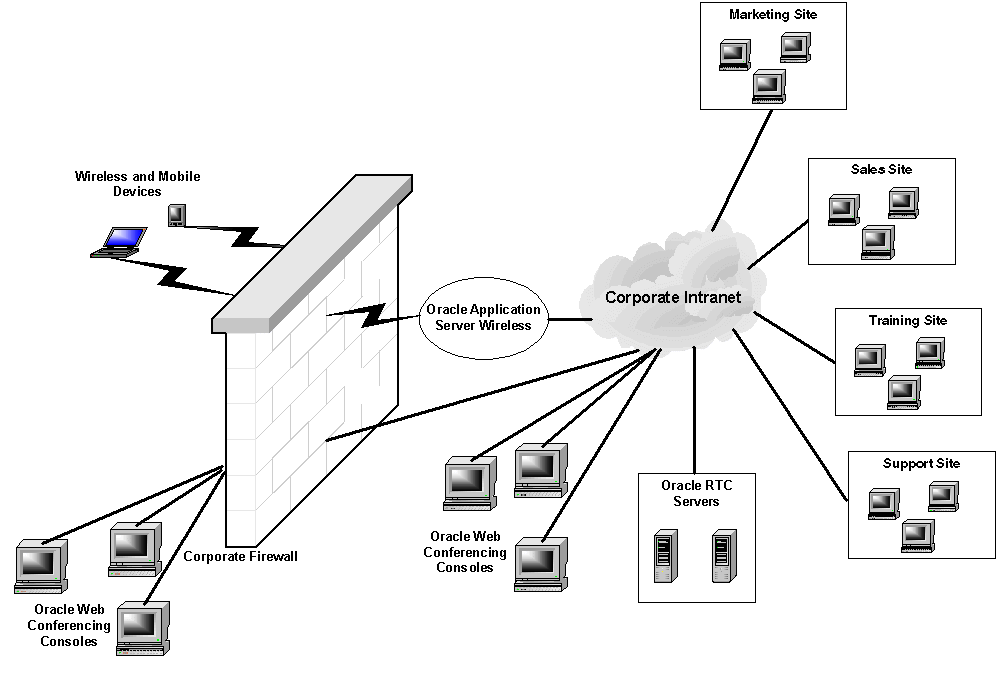| Oracle® Real-Time Collaboration Application Developer's Guide 10g Release 1 (10.1.2) Part Number B25461-01 |
|
|
View PDF |
| Oracle® Real-Time Collaboration Application Developer's Guide 10g Release 1 (10.1.2) Part Number B25461-01 |
|
|
View PDF |
Oracle Real-Time Collaboration Integration Services bring real-time collaboration within the context of the business applications in an enterprise. The Oracle Real-Time Collaboration system can be used to cobrowse Web documents, share desktops, conduct polls, chat, stream voice, and much more. Oracle Real-Time Collaboration facilitates real-time collaboration using a company's corporate intranet and the public Internet.
Oracle Real-Time Collaboration Integration Services can be used by the following groups:
Lines of business that want to easily use real-time collaboration functionality from within the context of their applications
Online e-businesses that want to quickly implement very valuable features like live help or "shop-together" from all their sites' Web pages
Help desks that want to dramatically improve customer satisfaction by providing desktop sharing with the click of a button
Sales organizations that want to quickly implement a system where its sales agents can use an existing application to provide live demonstrations of their products to their customers
Online learning organizations that want to enhance existing applications by providing recorded presentations of classroom material or interactive classrooms
Oracle Real-Time Collaboration Integration Services provides easy, industry-standard methods for any application to tightly integrate with the Oracle Real-Time Collaboration deployment within an enterprise. These services allow you to extend existing interfaces with real-time collaboration features. Examples of such scenarios include the following:
Extending web portals with SOAP services, servlets, and JavaScript modules: Support divisions can enable Oracle Real-Time Collaboration functionality in their end user interfaces. Support pages can be enhanced to provide indicators about the availability of support personnel, or groups or support personnel, and can provide hooks to initiate real-time chat conversations between the end users and the support personnel. These chat conversations can be upgraded to a Web Conference seamlessly.
Sales divisions can use Oracle Real-Time Collaboration functionality when demonstrating product features. A telephone call can be upgraded to a live demonstration using Web conferencing. Online sales collateral can be enhanced with presence indicators that users can use to initiate conversations with sales agents regarding product features.
Extending enterprise applications with SOAP services: Enterprise applications can be enhanced to provide real-time collaboration features in their workflow. For example, Human Resource applications can be enhanced to provide real-time access to HR personnel who are signed using their instant messenger client. Queries can be answered in real-time and employee requests can be processed faster, having a positive impact on employee productivity in the organization.
Extending desktop software with plug-ins, COM objects, Java SDKs and Messenger add-ins: Desktop software, such as Microsoft Outlook and Word, can be enhanced to provide real-time collaboration functionality. For example, a user preparing a document can seamlessly share the document with his supervisor for real-time feedback. Users can schedule appointments as Web conferences directly from common desktop applications, such as Outlook.
The Oracle Real-Time Collaboration system has been designed to let you have a single, centrally managed Oracle Real-Time Collaboration system, deployed in an enterprise, that provides real-time collaboration functionality to multiple lines of business at the same time. Each line of business can determine which Oracle Real-Time Collaboration features to expose and customize how they appear to their users.
Oracle Real-Time Collaboration Integration Services have been designed to use industry-standard SOAP XML messages and HTTP protocol for integration with Oracle Real-Time Collaboration system. The architecture facilitates a single deployment of Oracle Real-Time Collaboration in an enterprise to meet the requirements of all types of integrating applications. The integrating applications might not be co-located and managed by the same administrator as the Oracle Real-Time Collaboration deployment.
This model of integration lends itself very well in situations where Web applications are located in a distributed environment and need to expose real-time capabilities by integrating with a central deployment of Oracle Real-Time Collaboration.
Figure 1-1 Centrally-Managed Oracle Real-Time Collaboration System Supporting Multiple Lines of Business

Figure 1-1 illustrates how Oracle Real-Time Collaboration integrates with other applications. The Oracle Real-Time Collaboration servers are behind the corporate firewall. The following sites are located on the corporate intranet: Marketing, Sales, Training, Support. Through Oracle Real-Time Collaboration Integration Services, these sites expose Oracle Real-Time Collaboration functionality, which is provided by Oracle Real-Time Collaboration servers. Wireless and mobile devices can access Oracle Real-Time Collaboration functionality through Oracle Application Server Wireless. The Oracle Real-Time Collaboration servers also provide Oracle Web Conferencing functionality, which users can access through the Oracle Web Conferencing Console.
All interfaces of Oracle Real-Time Collaboration Integration Services are defined as Web-based services. These interfaces are implemented as a set of servlets that can be accessed using a URL. The parameters of the interfaces are sent as XML documents. These documents are sent as the payload of the HTTP request.
This integration model provides language and location independence.
Invoking a servlet requires a client with the ability to construct and parse XML schemas and send the XML document over HTTP. There is no dependency on any specific XML library.